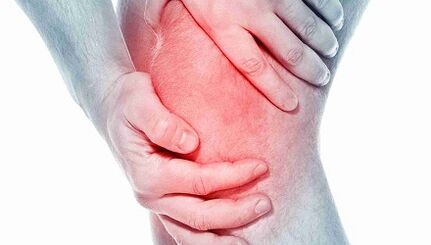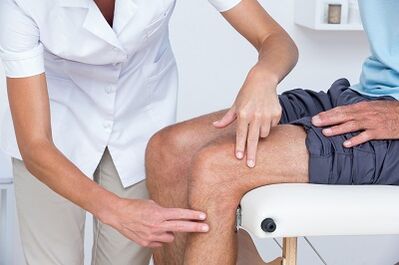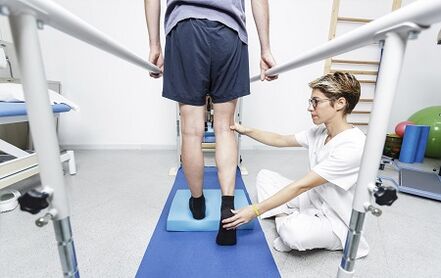Knee articulation is a chronic (long-term) degenerative disease that can cause damage to the cartilage in the joints.Symptoms include pain, stiffness, and swelling.Treatment options for pain and disability relief include lifestyle changes (diet, physical exercise), physical and professional treatments, medications and surgery.
Osteoarthritis in the knee joint
Osteoarthritis in the knee joint is a common disease with chronic pain.Recent clinical data show that central sensitization stimulates deformed osteoarthritis in the knee joint.How the effects on knee joints affect central treatment of pain is crucial to identify new analgesic targets/new treatment strategies.
The inhibitory receptor weakens the function of surrounding immune cells and regulates central neuroimmunity.The systemic introduction of receptor agonists in this model impairs OA-induced pain behavior, and changes in circulation and anti-inflammatory cytokines are manifested in this model.
Deformed joints
The deformed articulation of the knee joint is inflammation and wear of cartilage on the bones that form the knee joint (bone = bone, arro = artro = joint, ITIS = inflammation).The diagnosis of knee osteoarthritis is based on two main results: X-ray data on bone health changes (X-ray and magnetic resonance images using MRI) and human symptoms.About 14 million people have symptomatic knee arthritis.Although more common among older adults, 2 million of the 14 million people with symptomatic OA during the diagnosis period are younger to 45 years old and more than half are over 65 years old.
Osteoarthritis (OA knee) is a progressive disease caused by inflammation and knee arthritis that worsens over time.
This affects the entire joint, including bones, cartilage, ligaments and muscles.Its development is influenced by age, body mass index (BMI), bone structure, genetics, muscle strength, and activity level.After knee injury, OA knee can also develop as a secondary state.Physical therapy may be used to control the OA knee depending on the stage of the disease and the injury or presence of the disease associated with it.More severe or expanded cases may require surgical intervention.
symptom
People who develop knee OA may suffer from widespread symptoms and limitations depending on the development of the disease.Pain occurs when the bones that cover the knee joint wear out.Areas of cartilage worn or damaged cartilage expose the bones at the bottom.The effect of bones allows you to increase pressure and compression of cartilage, sometimes when you move, bones come into contact, which can cause pain.Since the knee is a joint, the level of activity, the level of activity, and the type and duration of action (usually) have a direct effect on the symptoms.Symptoms may worsen with weight movement, for example, when walking with heavy objects.

Symptoms of the knee joint may include:
- Pain worsens during or after surgery, especially when walking, climbing down, walking along stairs, or moving from sitting position to standing position.
- Pain or stiffness after sitting with a long time bent or straight knee.Pain is the most common symptom of osteoarthritis.As the disease progresses and inflammation, the pain becomes constant.
- The feeling of jumping out, cracking or grinding when moving your knees.
- Swelling after movement.
- Often, the rigidity of the affected joints is first seen in the morning and after rest.
- Sometimes touching warm edema can cause arthritis in the joints.
- Osteoarthritis may deform due to bone growth and cartilage loss.The growth of bones in the joints at the end of the finger is called the nodes of Hyberden.Jungle nodes are the growth of bones in the joints in the middle of the finger.Degeneration of knee cartilage can lead to the external curvature of the knee (onion feet).
- When arthritis moves, you can notice the sound of cracks or grate sensation.This is caused by rubbing the bone against the bone or cartilage.
Often, these symptoms do not appear suddenly, but gradually develop over time.Sometimes people don’t admit they have osteoarthritis because they can’t recall a certain time or injury that caused the symptoms.If knee pain worsens for several months and this does not respond to changes in rest or activity, it is best to ask the medical staff for advice.
diagnosis
Osteoarthritis can usually be diagnosed by its characteristic symptoms of pain, reduced movement and/or deformation.Osteoarthritis can be confirmed by X-ray or MRI scan.General data include narrowing of joint space between bones, loss of cartilage and bone spurs or growth of bone.Blood tests can be used to rule out other possible diseases, but osteoarthritis cannot be diagnosed.

In knee OA, there are 2 main processes diagnosed.The first is a report based on symptoms and clinical examinations.The physical therapist will ask questions about medical history and activities.The therapist will perform a physical examination to measure knee movement (range of motion), strength, mobility, and flexibility.They can also ask for various exercises to view, increase or relieve pain.
The second tool used to diagnose the knee joint is diagnostic visualization.Physical therapists can give X-rays of the knee to their doctors to check for damage to the bones and cartilage of the knee joint.
If more serious damage to the joint is suspected, you can order an MRI to study the overall state of the joint and surrounding fabric more carefully.
Blood tests can also be ordered to help rule out other conditions that may cause symptoms similar to knee osteoarthritis.
treat
Depending on the severity of the arthritis and the age of the patient, how to treat arthritis in the knee joint will be selected.Treatment may include manipulation or conservative methods or combinations thereof.
The first line of treatment for knee arthritis includes altered activity, anti-inflammatory drugs, and weight loss.
Rejecting actions that increase pain can make it acceptable to some people.Anti-inflammatory drugs help relieve inflammation that can cause pain.
Physical treatments to strengthen the muscles around the knee can help absorb part of the impact of the joint.This is especially true for arthritis in the knee cup (patelo-femoral).Special types of braces are designed to transfer load to a part of the knee that is smaller than arthritis and can also relieve pain.Injecting medications in the knee joint can also help temporarily.
Also, walk on the other side with a cane, as a painful knee can help distribute part of the load, thereby reducing the pain.Finally, losing weight helps reduce the force through the knee joint.A combination of these conservative measures can help relieve pain and prevent disability.
If these methods do not allow you to tolerate the disease, this procedure may be the best choice for treating knee arthritis.The exact type of operation depends on age, anatomy and primary state.Some examples of surgical options for treating arthritis include osteotomy, which involves cutting the bones to align the joints.
Modern methods for treating knee joints include osteotomy, which is a great option if the patient is young and the arthritis is limited by an area of the knee joint.This allows surgeons to rebuild the knee to unload the area of arthritis and relatively does not involve the part of the knee joint.For example, the patient can be reconstructed to redistribute the load through the joint.The advantage of this type of surgery is that it retains the patient's own knee joint and has the potential to ensure years of pain relief without the disadvantages of the prosthesis.Disadvantages include a longer recovery process and the possibility of arthritis in a recently escalated knee.
Surgery to replace the knee joint involves cutting the bones of arthritis and inserting the prosthetic joint.All arthritis surfaces are replaced, including the femur, lower leg and knee cup.The surface of arthritis is removed, and the ends of the bone are replaced by prostheses.Prosthetic components are usually made of metal and plastic surfaces that are designed to smoothly slide to each other.
Replace knee joints
The overall operation of replacing the knee joint was first performed in 1968 and has evolved over the years in a reliable and effective way to eliminate pain and allow the patient to return to their active life.Improvements in the field of surgical methods and implants help make this one of the most successful orthopedic procedures today.As the population ages and remains active, general replacement demand for general knees continues to grow.Many surgeries to replace the knee joint are performed in special surgical hospitals.Improvements in surgical techniques and design of new implants are some of the contributions made by surgeons.
People often wonder when and why the knees should be replaced.This is a personal question, depending on the level of human activity and functional needs.Many people with arthritis suffer from pain, which prevents them from attending events.Others are so weakened that they have difficulty wearing shoes and socks.Complete replacement of the knee joint provides solutions to problems that solve joint problems to reduce pain and restore activity.After successful complete replacement of the knee joint, the patient may expect surgery without pain.Complete replacement of the knee joint can significantly improve the patient's condition and greatly reduce their long-term treatment costs.This study shows that not only is the overall replacement of the knee joint cost-effective, but it also provides greater functionality and optimal quality of life.
Complete replacement of the knee joint is considered the primary operation and the solution is not trivial.Often, when people think they can no longer have arthritis, they decide to have surgery.
The implant consists of 4 parts: tibia, femoral parts, plastic inserts and patterns.The composition of the tibia and femur is made of metal, usually cobalt chromium, which is used to remove the ends of the thigh and lower leg after arthritis bone.The plastic insert is made of ultra-high molecular weight polyethylene and fits the tibial component so the polished thigh surface slides along the plastic.The components of the knee cup also slide toward the front of the femoral component.Usually they are attached to bone cement.
Complete knee replacement in the operating room through a special laminar air flow system, which helps reduce the likelihood of infection.Your surgeon will wear a "space suit" and is also designed to reduce the possibility of infection.The entire surgical team will include your surgeon, from two to three assistants and a babysitter.
Anesthesia is performed through an epidural catheter, a small canal inserted into the dorsal.During the operation, the patient was both awake and sleepy.
After the epidural mass is introduced around the thigh, a tourniquet or cuff will be placed.During the procedure, the horizontal bar will be exaggerated to reduce blood loss.The incision to completely replace the knee is made along the front knee.The incision will be from 4 to 10 inches according to the anatomy.
Arthritis surfaces of femur, calf and the bone are exposed and removed using intensity tools.At the same time, the deformation of the knee was corrected, and after the operation, the knee became straighter.The bone is ready to pick up the artificial knee joint and insert it into the prosthesis.During the closure, two drains were installed around the work area to help evacuate the blood.Juice is used to close the skin.

The entire operation will take 1 to 2 hours.Afterwards, the patient will be taken to the recovery room where the examination test is tested.Most patients can be taken to a regular room for several hours.Others have to stay in the hall to recover, which is the definition of surgeons and anesthesiologists.
After a complete operation, patients usually stay in the hospital for 3-4 days to replace the knee
Risks during surgery
Certain risks of surgical procedures include blood loss, formation of clots on the legs, and the possibility of infection.The general prevalence of these risks is very small.They should be discussed with the surgeon before the operation begins.
Some risks of prosthetic limbs include the possibility that parts will weaken or wear over time, or that the prosthesis may become infected.Again, these questions will be discussed with the surgeon.
Postoperative courses
After the knee joint is replaced with a full operation, the patient will immediately fall into the recovery room.After a few hours, most patients can enter the routine ward, feeling recovering in their legs.A pain relief pump associated with the epidural catheter will be given, which will allow you to control when to give a cure for the pain.
On the day of the surgery, you can perform some exercises, as shown by the physical therapist, including reducing the quadriceps femoris and moving the legs up and down.Depending on the surgeon's preference, you can bend your new knee immediately after the surgery or the first day.After the surgery, the patient will be allowed to get ice, but drink liquids, otherwise you may cause nausea.The patient will have a catheter in the bladder, so you don't have to worry about urinating.Once the legs are restored, it will be allowed to sit down, get up and take a few steps with the walker and therapist.
The first day after the operation, developed to help become more fluid.
The patient will meet with a physical therapist who will direct other exercises.Additionally, they will help to stand up and take a few steps.Typically, patients will be allowed to drink pure liquids.
Movement will be easier to move in the next few days.The patient will be released from the pain and urethral catheter.Treatment of pain will be given in the form of a tablet.The day after the operation, if signs of recovery are found in the intestine, you can eat regular food.
Depending on your age, preoperative physical condition and insurance coatings, the patient may be a candidate for short-term accommodation in the rehabilitation facility.Otherwise, the patient will be sent home and the physiotherapist will continue to recover from his home in the future.The dispatcher will discuss these options with the patient and will help him plan to go home.
Return activities will be directed by surgeons and therapists.Usually, patients can walk six weeks after the operation.Patients can resume exercise after 6 weeks.After 8 weeks, patients can resume competition in golf and swimming.They can play tennis for 12 weeks.The surgeon will help decide which actions can be resumed.
What physical therapist is needed

All physical therapists prepare for a variety of diseases or injuries through education and clinical experience:
- A physical therapist, experience in treating people with knee osteoarthritis and replacing knee joints after surgery.Some physical therapists have orthopedic focus practices.
- A physical therapist, a certified orthopedic clinical specialist.The physical therapist will have advanced knowledge, experience and skills that can be applied to the state.
- You can use MRI, an online tool to find physical therapists with these and other accounting data, an online tool that helps you find physical therapists with specific clinical knowledge.
General advice when you find a physical therapist (or any other healthcare provider):
- Get advice from family and friends or other healthcare providers;
- To seek help clinics for admission to physical therapy, you need to ask the physical therapist about his experience in assisting patients with arthritis.
During your first visit with a physical therapist, you need to prepare to describe the symptoms in more detail and report activities that make the condition worse.



















